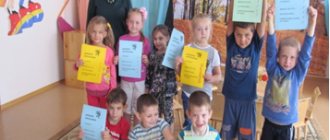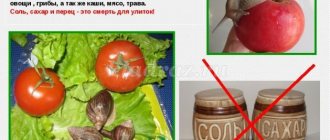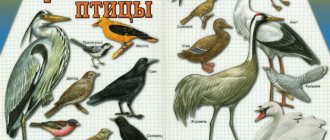Summary of an open lesson on speech development in the senior group “Space Travel”
Summary of an open lesson in the senior group of a preschool educational institution
Author: Tatyana Gennadievna Borodina, teacher of the senior group of State Budget Educational Institution Secondary School No. 289 (kindergarten No. 1867) in Moscow.
Summary of an open lesson on speech development in the senior group “Space Travel”.
Program content:
Objectives: Educational: 1. Formation of practical skills in using corrected (phonetically pure, lexically developed, grammatically correct) speech; 2. Replenishment, expansion, activation of children’s vocabulary; 3. Development of the lexical and grammatical basis of speech through the selection of various didactic games. Vocabulary: 1. Repetition and reinforcement of the sound P; 2. Consolidating the correct sound pronunciation in words, proverbs and poems; 3. Development of dialogical speech; 4. Development of the lexico-grammatical structure of speech during word formation and inflection. Educational: 1. Formation of moral qualities: willingness to help, sense of collectivism; 2. Nurturing a culture of verbal communication; 3. Cultivating attention to one’s own speech; interest in speech development classes. Preliminary work: 1. Introducing the sound “P” in a lesson on speech development; 2. Conversation with children on the topic: “Space” / who was the first astronaut, space planets / 3. Learning poetry with children; 4. Conducting classes in drawing, applications on the theme “space”, origami “rocket”; 5. Reading stories from the book “Flying Stars” by A. Tkachenko; 6. Examination of pictures from the series by L.B. Deryagin “For preschoolers about Russian space explorers” Material: pictures of planets, toys: Luntik, ball, audio recording of space music, laser flashlights to create the “starry sky” effect, large colored stars for constellations and small ones as encouragement.
References used: 1. L.B. Deryagin "For preschoolers about Russian space explorers." 2. N.V. Labodina Complex classes, senior group. Progress of the lesson.
- Guys, let's go on a space journey today! - What will we use to fly into space? /children: - On a rocket!/ - What is the first sound in the word ROCKET? - What will you and I definitely wear? /children: - spacesuit!/. — Is there an “R” sound in the word SCAFANDR? - Where is it located: at the beginning, in the middle or at the end of the word? We put on a spacesuit to fly into space, we learn a lot of new things, you just have to want it! — Our crew is ready for flight. Attention! Attention! Let's take flight! - Look, guys, how many stars there are around! The world of stars is diverse. On a cloudless, clear evening, the sky is strewn with many stars. They appear small because they are far away. In fact, stars are huge hot balls of gas, similar to the sun. — Nine planets revolve around our sun.
- Listen carefully to the poem about the planets. In order, all the planets can be named by any of us: One - Mercury, Two - Venus, Three - Earth, Four - Mars. Five is Jupiter, Six is Saturn, Seven is Uranus, followed by Neptune. He is the eighth in a row. And behind it, then, is the ninth planet called Pluto. (Arkady Khait) - The first planet is Mercury. (showing an image of the planet). This planet is closest to the sun, it is the smallest. Let's say this word together and remember the name of the planet! /On each planet, children complete tasks./ Assignment: Guess the riddles. 1. What kind of bird, scarlet tail, flew into a flock of stars? (rocket) 2. They have been studying the life of planets with a telescope for hundreds of years. Smart Uncle will tell us everything... (astronomer) 3. Not a month, not a moon, not a planet, not a star, it flies across the sky, overtakes airplanes. (satellite) /Children fly to another planet, imitating astronauts in space to space music, while my assistant directs laser flashlights to the ceiling and creates a “starry sky” effect/. — The second planet we arrived on is called Venus. (showing an image of the planet). It is very hot in here. Let's say this word and remember it. /children pronounce the word Venus and find the sound “r”/ Assignment: “Say the opposite”: Day - ... night Bright - ... dark Sun - ... moon Fly away - ... fly Land on the moon - ... land - Well, guys, you completed the task , it's time to move on. /Children fly to the next planet, imitating astronauts in space to the accompaniment of space music/. - Look out the windows, we are approaching a planet called Mars. The planet mars appears red and is visible in the sky as a reddish star. Let's say its name and remember it. /children pronounce the word MARS and find the sound “r”/ Space physical education The sun is shining in a clear sky, An astronaut is flying in a rocket. (Stretch - arms up). And below there are forests and fields - (Bend over). The ground is spreading. (Spread your arms to the sides). - Guys, let's take off! Ahead of us is a meeting with other amazing planets. — Do you know who was the first cosmonaut? Yes, on April 12, 1961, Yu. A. Gagarin flew into space on the Vostok spacecraft. Since then, every year on April 12, our country celebrates Cosmonautics Day... - Guys, listen to the poem called: “Yuri Gagarin” In a space rocket With the name “Vostok” He was the first on the planet to rise to the stars. Spring Drops sings songs about this: Gagarin and April will be together forever. /Children fly to another planet, imitating astronauts in space to cosmic music, while my assistant directs laser flashlights at the ceiling and creates a “starry sky” effect/. We are approaching the planet Jupiter, over which a threat hangs, it needs help to stay in the Universe! And for this you need to complete the task. Assignment: “Make a sentence using a picture.” For example: “rocket” - A rocket flies into space. “moon” - The moon is shining in the sky. “constellations” - The stars in the sky form constellations. - Guys, it's time for us to move on! /Children fly to another planet to the accompaniment of cosmic music/.

- Look out the windows - we are approaching the planet Saturn. (showing an image of the planet). Please note - this planet is surrounded by rings, let's say the name of the planet and remember it. /children pronounce the word Saturn and find the sound “r”/. Assignment: “Form the plural.” For example: rocket-... rockets; comet - ...comets; planet-...planets; astronaut-...astronauts, with constellation-...constellation. — Guys, what constellations do you know? /children’s answers: ursa major, microscope, peacock, hounds, fly, cross, southern crown, compass, etc./ Game “Make a constellation” / Children are divided into teams and use the pattern to lay out their constellations from stars./ Game “ It flies - it doesn’t fly.” If I say the word that flies, you raise your hands. What doesn't fly, you don't raise your hands. But be very careful, because I will confuse you. - Does the plane fly? ...Flies. — Does the Lunokhod fly? ... Doesn't fly - Does the astronaut fly? ...Flies. — Is the satellite flying? ...Flies. - Does the star fly? ... Doesn't fly. - Does the helicopter fly? ...Flies. - Does the rocket fly? ...Flies. /Children fly to another planet to the accompaniment of cosmic music/. — We are flying to the planet Uranus. It is the seventh planet farthest from the sun. It's very cold and dry here guys. - Now Vanya will tell us a poem: “Gagarin” A rocket flies, flies around the world, And Gagarin sits in it - a simple Russian guy! /Children fly to another planet to the accompaniment of cosmic music/. - Guys, we still have two planets left to reach in the solar system - Neptune and Pluto. These planets, like Uranus, are far from the sun and therefore very cold on them. To keep us from freezing and getting sick, we need to complete one more task. Assignment: “Call me kindly.” For example: star -…asterisk; cloud-...cloud; sun -...sun; sky -... sky; airplane -... airplane; helicopter -...helicopter. - Well done guys, you completed the task. - Guess which planet we are going to now? This planet is our beloved home, We live on it from birth to death. The planet is beautiful: seas, oceans. There are flowers and trees there, different countries, And the sun shines from dawn to sunset, what kind of planet is that, tell me guys!
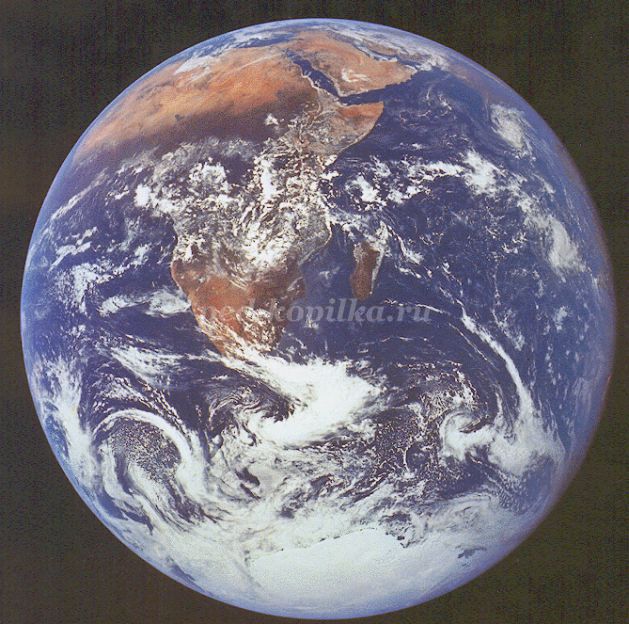
- Look out the windows, we are approaching the most wonderful, most beautiful and beloved planet Earth. — Guys, planet Earth has its own satellite. — Listen to the riddle and guess what Earth’s satellite is. Only the full sky is visible better than the stars... (moon). — Guys, “Luntik” came to visit us from the Moon. He wants to play with you. Quiz game "Guess it." — The largest and hottest star in the universe (Sun). — A person who flies into space (astronaut). - What is the name of the aircraft in which they fly into space? (Spaceship). — What is the name of both the animal and the constellation? (Bear). - Why is there day and night on earth? (The planet revolves around itself) - Who was the first astronaut to fly into space? (Yuri Gagarin). — Who else has been in space besides people? (Dogs Belka and Strelka, mice, rats, rabbits and even chimpanzees). — What was the name of the spaceship on which Gagarin made his first flight? (“Vostok”) - What holiday does our country celebrate every year on April 12? (Cosmonautics Day). - Guys, listen to the poem called: “Yuri Gagarin” “A ship is flying” A steel ship is flying in space, Around the Earth. And even though its windows are small, everything is visible in them as if on the palm of your hand: the expanse of the steppe, the surf, and maybe you and me too! (author of the poem - V. Orlov) - Guys! Our journey has come to an end. Did you enjoy traveling around the planets? What do you remember most? “Now Luntik will give all of you guys stars as a souvenir of our journey.”
We recommend watching:
Poems and ditties for Cosmonautics Day for kindergarten Scenario of thematic leisure time for Cosmonautics Day in kindergarten Summary of educational activities in the middle group on the topic “Oh, if only I were an astronaut” Design of a preschool educational institution for Cosmonautics Day
Similar articles:
Abstract of GCD in the senior group on the topic: Space
Summary of an integrated lesson in the senior group on the topic “Space”
English lesson at preschool educational institution. Drawing a space rocket
Research and creative short-term project for older preschoolers “Cosmos” - “Space”
Game – journey for older preschoolers “Flight into space”
GOALS:Educational:
• Activation of the dictionary: verb forms, signs of objects, circumstances
• Literacy training: development of phonemic awareness and consolidation of letter knowledge; development of syllabic reading skills
• Coherent speech: development of creative storytelling skills, the ability to adhere to the chosen line in creative storytelling
• Grammar: constructing sentences such as judgments
• Sound culture of speech: teach children to pronounce words clearly and loudly
Educational:
• Formation of the skill of active monitoring and evaluation of performance results
• Formation of the skill of expressing one’s opinion
• Development of the ability for collective creativity
MATERIALS FOR THE CLASS
• Photo illustrations or pictures depicting a spaceship, starry sky, lunar landscapes, planets of the solar system, with views of the Earth from space
• Crossword puzzle tables (these can be on large sheets of paper or on a board)
• Cut-out pictures depicting various landscapes
1 The lesson notes have been compiled for children in the preparatory group. When using it for classes with older children, you can exclude the task of guessing a crossword puzzle.
PROGRESS OF THE CLASS
PART 1
Introduction to the topic of the lesson
Educator: Our lesson today is not entirely ordinary. So that you understand what we are going to talk about today, guess the key word of our lesson. We will guess it by letter and write it in these cells:
1 2 3 4 5 6
In the third cell we write down the letter that is hidden in the word “dream”. In the word “sleep” this letter comes first.
In the sixth cell we write down the letter that is hidden in the word “sedge”. In the word “sedge” the letter we need is in second place.
In the first cell we write down the letter that is hidden in the word “fairy tale”. In the word “window” this letter is in second place.
In the fifth cell we write down the letter that is in third place in the word “mole”.
In the fourth cell we write down the letter that comes last in the word “suit”.
In the second cell we write down the letter that is in fourth place in the word “salon”.
After completing this task, children read the keyword “space,” thus determining the topic of the lesson.
Note: each teacher can choose the words for this task independently. It is important that the vowels are stressed and the consonants sound clear so that children do not have doubts about their meaning. For example, to recognize the sound “b”, you should never give the word “hawk” (you hear not “b”, but “p”). It is better if there are vowels after the consonants.
PART 2
Work on the grammatical structure of speech Construction of common sentences such as judgments
Educator: I suggest you go on a space journey today. What will we take on our trip? Of course, on a spaceship. First, let's prepare for the flight, collect everything you need. But there should be nothing superfluous or random on the spaceship. Therefore, we will take only those things that line up in a logical chain, as if clinging to one another. We will choose them from the pictures that are laid out on this table. For example, I put the first picture of products on the flannelgraph. Do we need groceries on the flight? Of course, the flight will be long. To prevent food from spoiling, you need a refrigerator, so next I will put a picture with a refrigerator. Now you continue to select pictures.
Further, pictures can be selected in the following areas: to repair a refrigerator, tools are needed (picture with tools), the tools are stored in a special case (picture with a case), medical supplies can also be stored in the case (picture with a first aid kit); or in order to eat food, you need dishes (picture with dishes), the dishes are stored in the closet (picture with the closet), books can also be stored in the closet (picture with books, etc.)
PART 3
Vocabulary development Educator: We have collected everything necessary for the flight. Now stand in a circle, let’s put on special suits for astronauts - spacesuits. Imagine that you entered the ship, looked around... And what do you see? Try to talk about it with our game
"Magic wand". The stick, as always, goes in a circle. The one who took the stick says the word. Remember, it is important that the words in our circle are not repeated, otherwise the magic wand will stop and will not pass to another player. And you and I together must make sure that the words are not repeated. So, I saw a control panel in the spaceship, with which you can control everything that happens on the ship.
The teacher passes the stick to the next player, who says his word and passes the stick on. Children mark violations of the rules of the game by stomping their feet.
Children can name various devices, portholes, a kitchen, astronaut lounges, a library, a TV, a shower, armchairs, a spacesuit storage room, tools, computers, plants or experimental animals, pantries, etc.
When the stick goes all the way around, the teacher asks the next topic for conversation.
Educator: Now let's think about what we can do in a spaceship. We can observe the devices...
Children can list the following words and phrases: repair, troubleshoot, eat, sleep, read books, look out the window, take a shower, cook, control a ship, fly (because there is zero gravity in a spaceship), do physical exercise, etc. .
Educator: So, we found out that people can move inside a spaceship. How do they move?
Children list: slowly, quickly, smoothly, clumsily, accurately, rapidly, barely, like a turtle, etc.
1 The games “Magic Wand”, “Find Your Group” and “Cut Pictures” were developed by psychologist E.V. Ryleeva, author of the “Discover Yourself” program.
Educator: And now we come to the porthole and look through it at our planet. What does it look like from space? (Small; spherical; blue because you drink a lot of water; sparkling from the sun’s rays). What does our sun look like to us? (Very bright, blinding, shining...) How do you see stars in space? (They look like bright points, there are a lot of them, they are scattered throughout the sky, etc.)
PART 4
Development of phonemic hearing Isolation of sound in a word
Educator: We have gotten a little comfortable on our spaceship. You just told me that cosmonauts not only work, but also relax. And just imagine, they also love to play during their holidays. So you and I will play letter lotto.
All children are given cards and cards. The teacher (or child) has a bag with magnetic letters in his hands. He pulls letters out of the bag and says, for example: “Who has the letter M?” A child who has a picture on the card, the name of which begins with M, answers: “I have a bear” - and covers the indicated picture with the card. The teacher checks and prompts.
PART 5
Coherent speech Compiling a collective story from pictures Educator: And now we have flown up to the planet that we must explore. We took several pictures of the planet. But when the device printed our pictures, it turned out to be separate fragments. Here they are. (The teacher gives each child one fragment of the picture.) Your task is to create whole pictures from the fragments.
The game “Cut Pictures” is played. It can be organized in two ways.
1. The shirts in all the pictures are different colors. Children are divided into subgroups based on the color of their shirts. Each subgroup puts a picture on their table.
2. The shirts in all the pictures are the same color. The teacher only says that each picture is cut, for example, into 4 parts. Children themselves must determine into which subgroups they need to be divided. This game will be even more interesting and complex if you discuss the rule in advance: you cannot consult with each other, everything must be done silently, without uttering a word. Each of the children must determine which of the pictures his fragment fits, which subgroup he should join. Of course, this option for organizing the game is used only when the children are already familiar with the game.
After the pictures are compiled, the teacher gives the next task.
Educator: We must convey to Earth what we saw on this distant planet. But we are already so far from Earth that we cannot transmit the image. We can only communicate by voice. Therefore, we must tell everything that is shown in our pictures. Let's agree this: you make up a story based on your picture all together. Someone starts a story, then a second one continues it, then a third one, and a fourth one finishes it.
This task has a great educational effect in terms of developing social skills in children: they should be able to negotiate within their microgroup of 3-4 people and coordinate their opinions.
At the end of the lesson, if there is still time left, the teacher can offer the children an entertaining crossword puzzle “Solar System”.
1. A planet in the solar system, which in ancient times was called the “planet of war” for its red color.
2.The farthest from the Sun and the smallest planet in the Solar System.
3. Earth satellite.
4.The second planet from the Sun in the Solar System, a neighbor of the Earth.
5.What is the planet Saturn famous for? 6.The largest planet in the solar system.
Summary of GCD in the preparatory group with a presentation on the topic “Space”
Summary of direct educational activities on the topic “SOS” in space” (using information and communication technologies)
Author : Tushmakova Natalya Nikolaevna Topic : “Space” Goal : enrich children’s knowledge on the topic “Space”, consolidate skills and abilities in working with an interactive board . Tasks : Speech development:
- consolidate active vocabulary on the topic “Space”;
- develop dialogical speech (be able to express and prove your point of view); - consolidate the ability to select words - antonyms; - practice agreeing numerals with adjectives and nouns; - exercise the ability to solve puzzles; — continue to learn to answer in complete common sentences, develop coherent speech. Cognitive development:
- consolidate knowledge about the solar system, the sequence of arrangement of the planets of the solar system in their orbits, generalize and expand children’s knowledge about the characteristics of the planets;
— introduce the biography of the first cosmonaut Yuri Gagarin; — consolidate the ability to navigate on a plane, work according to a diagram; - practice counting backwards, adding and subtracting within 10; — practice the ability to work with an interactive whiteboard and use the toolbar. Social and communicative development:
- consolidate the ability to carry out independent joint activities in pairs, develop communicative qualities, friendliness; — improve teamwork skills.
Progress:
1. Surprise moment - Guys, today I received a strange letter by email, let's read it (children read the message on the laptop monitor): “SOS! Earthlings, help! We are your friends, but we live on the planet Mars. We have a problem, our planet is filled with garbage. Help us!" - Well, guys, let's help our friends from Mars? (Yes!) - I’ll take a carriage, harness a couple of horses into it, and we’ll rush off. Do you think we'll get there? (No). Why? “Then I suggest we go in the fastest car.” Do you think we'll get there? Why? - So what will we go on? (on a rocket). Why exactly a rocket? (children's answers). —Who controls the rocket? (astronauts). -What should astronauts be like? (Strong, dexterous, decisive, skillful, disciplined). —Are you ready to become such astronauts? (Yes). 2. Game “On the contrary” (with a ball in a circle). Let's check readiness for flight: take off - and vice versa... (land), bright - dim, dark - light, fly - fly, far - close, high - low, long - short, up - down, light - heavy, hot - cold, cowardly - brave, on - off, slow - fast, giant - dwarf. - Well done guys, everyone is ready for the flight! 3. Orientation according to the plan - We are at the cosmodrome. What kind of place is it? (this is the place from where space rockets are launched). A space rocket is waiting for us. Let's use the diagram to find a spaceship that is ready to fly into space (each child has a paper assignment, children work independently at tables).


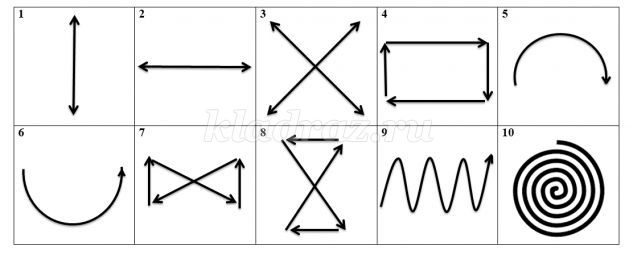
I want to give all the astronauts who have been in space the album “Space Journey” with stickers, in memory of our unusual adventure. Presentation for the synopsis of the GCD on the topic “SOS” in space"
We recommend watching:
Integrated lesson in the preparatory group “Travel to the Islands” Notes of educational activities for children of the preparatory group with a presentation on the topic: Rainbow Notes of a lesson on speech development in the preparatory group with a presentation. Retelling of the story by Sukhoml Lesson for older preschoolers on the world around them on the topic “Pets” with presentation
Similar articles:
Summary of GCD in the preparatory group on the topic: “Surprises of Autumn”
Summary of GCD in the preparatory group. In the land of kindness
Summary of GCD in the preparatory group “Journey through the autumn forest”
Summary of GCD in the preparatory group “Journey into Nature”
Abstract of GCD on ecology in the preparatory school group
